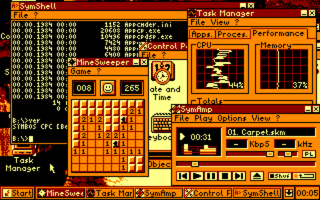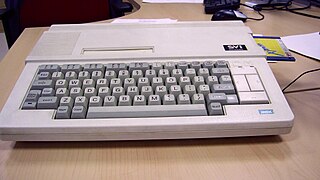
MSX is a standardized home computer architecture, announced by Microsoft and ASCII Corporation on June 16, 1983. It was initially conceived by Microsoft as a product for the Eastern sector, and jointly marketed by Kazuhiko Nishi, then vice-president at Microsoft and director at ASCII Corporation. Microsoft and Nishi conceived the project as an attempt to create unified standards among various home computing system manufacturers of the period, in the same fashion as the VHS standard for home video tape machines. The first MSX computer sold to the public was a Mitsubishi ML-8000, released on October 21, 1983, thus marking its official release date.

The Matra & Hachette Ordinateur Alice is a home computer sold in France beginning in 1983. It was a clone of the TRS-80 MC-10, produced through a collaboration between Matra and Hachette in France and Tandy Corporation in the United States.

The TI-99/4 and TI-99/4A are home computers released by Texas Instruments in 1979 and 1981, respectively. Based on the Texas Instruments TMS9900 microprocessor originally used in minicomputers, the TI-99/4 was the first 16-bit home computer. The associated video display controller provides color graphics and sprite support which were only comparable with those of the Atari 400 and 800 released a month after the TI-99/4.
MSX BASIC is a dialect of the BASIC programming language. It is an extended version of Microsoft's MBASIC Version 4.5, adding support for graphic, music, and various peripherals attached to MSX microcomputers. Generally, MSX BASIC is designed to follow GW-BASIC, released the same year for IBM PCs and clones. During the creation of MSX BASIC, effort was made to make the system flexible and expandable.
Spectravideo International (SVI) was an American computer manufacturer and software house. It was originally called SpectraVision, a company founded by Harry Fox in 1981. The company produced video games and other software for the VIC-20 home computer, the Atari 2600 home video game console, and its CompuMate peripheral. Some of their own computers were compatible with the Microsoft MSX or the IBM PC.

The X68000 is a home computer created by Sharp Corporation. It was first released in 1987 and sold only in Japan.

The TMS9918 is a video display controller (VDC) manufactured by Texas Instruments, in manuals referenced as 'Video Display Processor' (VDP) and introduced in 1979. The TMS9918 and its variants were used in the ColecoVision, CreatiVision, Memotech MTX, MSX, NABU Personal Computer, SG-1000/SC-3000, Spectravideo SV-318, Spectravideo SV-328, Sord M5, Tatung Einstein, Texas Instruments TI-99/4, Casio PV-2000, Coleco Adam, Hanimex Pencil II, and Tomy Tutor.

The Yamaha V9958 is a Video Display Processor used in the MSX2+ and MSX turbo R series of home computers, as the successor to the Yamaha V9938 used in the MSX2. The main new features are three graphical YJK modes with up to 19268 colors and horizontal scrolling registers. The V9958 was not as widely adopted as the V9938.

The Yamaha V9938 is a video display processor (VDP) used on the MSX2 home computer, as well as on the Geneve 9640 enhanced TI-99/4A clone and the Tatung Einstein 256. It was also used in a few MSX1 computers, in a configuration with 16kB VRAM.

The SV-318 is the basic model of the Spectravideo range. It was fitted with a chiclet style keyboard, difficult to use, alongside which sat a combination cursor pad/joystick. This is a disc-shaped affair with a hole in the centre; put a red plastic 'stick' in the hole and it is a built-in joystick, remove the stick and it is a directional arrow pad for word processing etc. This machine also had only 16 KB of user RAM, which limited its usefulness, though this could be expanded via an external peripheral box.

The SV-328 is an 8-bit home computer introduced by Spectravideo in June 1983. It was the business-targeted model of the Spectravideo range, sporting a compact full-travel keyboard with numeric keypad. It had 80 KB RAM, a respectable amount for its time. Other than the keyboard and RAM, this machine was identical to its little brother, the SV-318.
MSX-DOS is a discontinued disk operating system developed by Microsoft for the 8-bit home computer standard MSX, and is a cross between MS-DOS 1.25 and CP/M-80 2.

SYmbiosis Multitasking Based Operating System (SymbOS) is a multitasking operating system for Zilog Z80-based 8-bit computer systems.
The Geneve 9640 is an enhanced TI-99/4A clone. It was sold by the company Myarc as a card to fit into the Texas Instruments TI Peripheral Expansion System. Released in 1987, it is in many ways similar to the earlier TI-99/8, which was in prototype form in early 1983. The Geneve 9640 was designed by Paul Charlton, and the graphical swan on the boot up screen was designed by Mi-Kyung Kim.

The Spectravideo SVI-738 X'Press is an MSX1 compatible home computer manufactured by Spectravideo from 1985. Although compatible with the MSX 1.0 standard, it incorporates several extensions to the standard ; many are hardware-compatible with the MSX 2.0 standard but the system as a whole is not, leading to it being referred to as an "MSX 1.5" computer.

The Panasonic FS-A1WSX released in 1989 was the last MSX2+ made by Panasonic. It was the successor of FS-A1WX and incorporated few changes like S-Video output, no tape support, color printer support and an improved A1 Internal Cockpit software with a Kanji color word processor.
The HB-F9P was a Sony MSX2-computer, launched in 1985. The abbreviation HB stands for Hit Bit.
The EXL 100 is a computer released in 1984 by the French brand Exelvision, based on the TMS 7020 microprocessor from Texas Instruments. This was an uncommon design choice but justified by the fact that the engineering team behind the machine came from Texas instruments. It was part of the government Computing for All plan and 9000 units were used in schools.












